|
This pasta is a show-stopper (and delicious). It's extravagant in that it requires one bottle of drinkable red wine for about four serves. Details below. During the 'Lockdown", I have been part of an on-line group (mainly as observer) that connects by posting a daily photo of dinner on FaceBook. These are not professional cooks but an international, mixed bunch of people, staying/working from home. At the beginning, some were quick to point out that they did not cook; they were too busy, their jobs, their social lives and net-working obligations were so intense that they just had to eat out most nights of the week. I didn't buy it. In amongst the happy choppers there were also those who were rather startled to find they were enjoying themselves. I've always said cooking was better than yoga. It was interesting to watch the group grow, not just in number but in confidence and range. At first hesitant and apologetic, as the same names came up over and over, they showed more flair, more adventurous techniques. But some thumbs down...
Left: Deliciously juicy Right: "Healthy" variety but some dressing please, some juiciness please. And it seems that baking is the new status symbol, the new "power" activity. We have the time to make something that is a luxury in that it is not totally necessary. And there was good baking and sad baking, the worst being a pumpkin and apple tart made without sugar or butter so that it was "healthy". No image recommended. Left: - a bun to be proud of.
Right: "breaking bad" with rhubarb. The most controversial observation I make is there is "too much pasta". There is too much pasta being prepared/eaten/ordered - a carbohydrate overload. Pasta is not a meat or fish substitute, pasta is not a vegetable substitute. It's a filler. It's a carbohydrate. It's a flavour carrier; part of a course, not something to build a meal on. (A potato is in fact more nutritious.) Kids are leaving home and getting used to living on the stuff, the only thing they have been taught to prepare. Pasta is not a meal, it's a course. (I've written this and Krakatoa has not erupted!) I'm not being culturally insensitive. Living on pasta is like living on cake or bread and dripping. Fine every now and again but... Any self-respecting Italian will tell you it's part of a fuller meal. That said, I've become obsessed with the red pasta below and perfected the quantities enough to pass it on.. Share what you're thinking. Click on the small blue "comments" below.
2 Comments
Our Gastronomy Book Club was humming along nicely when the "Lockdown" happened. Yes, we should have zoomed. We might have to look into this but nonetheless, we're still reading. The book for 25th May is The Umbrian Supper Club - Marlena de Blasi. It's nomination had a mixed reception, so we hope for some lively comments. I am not too sure about this book but it did introduce me to the idea of cooking pasta in red wine. (In fact, the Umbrians seem to cook with wine as though it were water! I must investigate.) I've played with this and I'm now confident I can pass on the method. Left: Have everything ready
Right: Red wine pasta with figs and blue cheese Pasta Cooked in Red Wine For 2 people as a course within a meal. (Until you have the hang of this, don't try more than four serves at a time). 120 gm pasta (penne) 500 ml (2 cups) red wine 20 gm (1/4 cup) finely grated pecorino 30 gm butter (or 2 tbsp olive oil) 1/2 tsp freshly ground black pepper 1/4 tsp chilli flakes 1 clove garlic, finely chopped Either 50 gm cubed pancetta (or bacon) or 30 gm chopped walnuts This is not so much a recipe as a technique. Be patient. Have ready....
I like to use scales. Once you've made this you may like to adapt to cup measures. Choose a drinkable (cask is fine) full-bodied red - Cabernet Sauvignon or Shiraz rather than Pinot. Choose either pancetta or walnuts, not both IMO. I've chosen to served it with figs, halved, topped with some blue cheese and grilled, to start a meal, but it could also accompany a main course. Any ideas? How did you go? Share by clicking on the small blue "comment" below.  The new home page - a reminder that soon we might have a nice cup of tea and a madeleine together. Royal Doulton (De Luxe c.1935) tea set I've been too careful to use. That attitude stops now! Not not my pantry. I wish. I did do a yearly clear up, sort and tidy a few weeks before we had to lie low. It's been said, derisively, that it's about control. You betcha it's about control. Feeling in control (and knowing where things are) is my rod, my safety net, my security blanket. We have our demons and we deal with them how we can. We have our personal way of getting through. If you're a messer, that's fine. But to quote Dr Phil, "And how's that working for you?" Above a tidy drawer (for a tidy mind, haha). While some in the community were tackling their pantry and kitchen shelves I got to work on my stationery drawers, all five of them. They were certainly the result of hoarding or rather years of tossing something, to simply get it out of sight. As well as an embarrassing number of systems and boxes that had promised to finally get stuff in order, there were enough biros, pencils, staplers, rubbers, batteries, paper clips, sharpeners, tape rolls, bluetack and homeless keys to last until 2050. While throwing out dried-out biros and rock-hard erasers, I re-discovered various fountain pens, including a 1960s streamlined Parker from a mixed auction box. A satisfying hour was spent "servicing" them all and filling them with various coloured inks, (more than enough ink to transcribe the complete works of Proust.) Best of all, I was re-aquainted with my lovely Montblanc pen. We made friends and it will now never leave my side. So you have hundreds of postcards. You collected them (as essentials) while travelling, checking out the museum shop, at the craft shop of that small sea-side town. You know you'll get to send them, one day. Well now is the time. Resist sorting them (unless you have absolutely nothing else to do). Just take the first from the top. (This could turn into an ironic, zany joke; the Madonna in Assumption for a devout atheist, coffee pots through the ages for a friend missing her Tall Decaf Soy Skinny Vanilla Latte Frappé.) Let's keep the solitude but still connect. Bring joy. Don't Zoom. Send a card. There's not much room for writing; just a "Hi! Thinking of you. Hope you're well " will suffice. And you get to clear out a few cards. (You will have to find a pen, find the address and brave the outside world to buy stamps. But you'll manage.) A final frontier - those cute miniature tubes of face-cream, the little gift with purchase or the complimentary airline "comfort" pouches. We love a gift and when we get home, we just dump it and forget it. But these small things can still cause a twinge of guilt when you spot them at the back of the drawer.
Gather them all together, and into a small jar squeeze them out, slit them open with nail scissors; the lotions that promised to resurrect, soothe, lift, hydrate, moisturise, detoxify, brighten, perfect, replenish, relax; the serums, the night, the day, the eye creams, the neck creams. Blend with a saté stick. This will make a good hand-balm and with all the hand washing and alcohol sanitiser, you're going to need it. (And trust me, you won't grow eye lashes on your wrist by transporting eye cream to an alien area.) Love you to comment. Click the very, very small "comments" below 👇. The supermarket - the choice is yours. Tins or Fresh. I stand before you chastened. My comments in the post of 1/1/2020 mocked the over-use of hand sanitisers and house sprays. I talked of "lightening up" on the germ front, I suggested kids get into the dirt and play. Now, we are in lockdown, separated from each other, hounded by the universal spread of this rogue virus. We follow our daily dose of media because it all seems simply incomprehensible (and heart breaking). I'm taking the cautions seriously. Personally, I have to admit, I'm fine. I don't associate boredom with solitude. The playwright Tom Stoppard is enjoying the peace, he says. "This is the life I’ve always wanted — social distancing without social disapproval". I'm carefully avoiding the panic shopping, in fact it's fascinatingly humorous. Loo paper, bottled water, pasta (of that more later) leave behind mounds of fresh fruit and vegetables. Butchers hold a healthy variety of good meat, fish is still swimming in the ocean and being caught. What are these panickers eating? There might be a shortage of latex gloves but there's no shortage of good, local food. To paraphrase our government - "Together, we can cook our way through this." (Can we ask the media to stop paraphrasing - " Love in the Time of Cholera" by Gabriel Garcia Marquez (1985) unless they've read the book?") Waiting is what we have at the moment, and if you need variety and innovation in your cooking, check the site “ckbk” (https://www.ckbk.com). It's offering 30 days free subscription. “ckbk” is a digital collection of cook books, brought together through the expert advice of world-class chefs and food writers (including yours truly), sourced worldwide. It even ranks the most essential books of all time. See their list - 1000 top cook books and the list continues to grow. (And who doesn't love a list?) Incidentally, according to their poll, (https://app.1000cookbooks.com/books) the list begins as follows... #1 Mastering the Art of French Cooking Julia Child #2 Nose to Tail Eating Fergus Hendersen #3 The French Laundry Cookbook Thomas Keller #4 Larousse Gastronomique Prosper Montagné #5 French Provincial Cooking Elizabeth David #6 White Heat Marco Pierre White Subscribers get unlimited access to the complete content of every book. 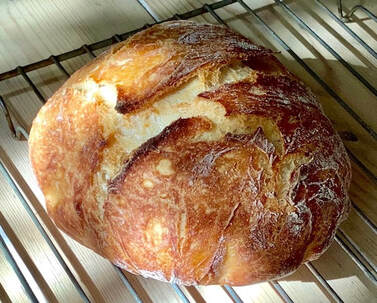 Left: Rosemary's perfect loaf Friends are cooking. Most of all, they’re baking and preserving even though bread, jams and chutneys are not part of the stockpilers' booty. People who once boasted they were too busy (inferring not too subtly, that they were above it all, with better things to do) are making not only dinner but interesting breakfasts (which they now have time to eat) and are finding they are quite good at it. 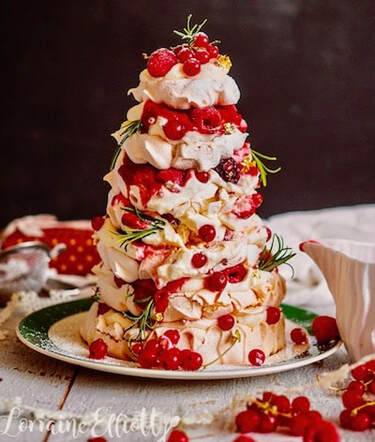 So, if baking is to be your "boredom filler" of choice, take the humble Pavlova to new heights with Lorraine Elliot's blog, nicely named "Not Quite Nigella". You'll never turn off the oven. https://www.notquitenigella.com  And treat yourself to the enthusiasm of young Gallic cutie Alex - The French Guy. Random YouTubes will find him exploring methodically (and with a laugh) anything from pasta to pommes de terre in his workshop or cycling around Paris. He's just finished a three part series on the perfect meatball, (just what you've always needed). https://alex meatball youtube His fridge magnets sold out too quickly, where he sensibly reminded us...
So finally, could self-isolating be just another name for self-improving? Love you to comment. Click the very, very small "comments" below 👇. Just clearing the bits and pieces clogging my brain so I can fully embrace 2020. These are the desserts that need only a spoon. The rest, fork and spoon please! Left: Lemon posset with raspberries - 1960s demitasse, Arzberg Right: Raspberry sorbet by C.M. - "custard cups" c.1910 Must accept that I can’t change the world. (Who’s listening?) At restaurants, at check-outs, I'm still being asked, “So, how’s your day been so far?” Sorry, I don’t know you well enough to tell you. (Management training needed?) Still not given a fork with my dessert cutlery, only a spoon, so I’m expected to use my thumb. (Surely this wouldn't increase staff wages.) Cheese (festooned with garden debris and chocolate-coated strawberries) still being arranged on hefty boards that are too heavy to pass. Is this the idea? If it can't be passed, it won't be eaten. (It is OK to put cheese on a plate.) Moral Outrage I felt anger on receiving an invitation to celebrate International Women’s Day with Champagne and a decadent three course lunch. The fizz is nice but actually domestic (not Champagne) but a decadent lunch? Why is good food decadent? This is so puritan. Guilty pleasures? If you feel guilty, you shouldn’t be doing it. It was easy to decline as I was asked to launch a new venue (fare) at the Whitmore Sparkke hotel and brew house run by women, the restaurant kitchen headed by the joyously talented Emma McCaskill. What did I learn in 2019? I learnt to save some pasta cooking water, re-adding it to the drained pasta, stirring for creaminess. (See cacio e pepe) Where is the natural? I am sick of labels, labels, labels on food; vegan, gluten free, lactose free, artisanal, hand-harvested, healthy, even no cholesterol. I thought “cholesterol” went out years ago. (Did you know that salt is gluten free, lactose free, vegan, vegetarian, paleo, sometimes hand-harvested, healthy and contains no cholesterol? No need for labels or even use-by dates.) "Eat food, not too much, mainly plants" - Michael Pollan Known Since the Dawn of Time I’m suspicious of heirloom vegetables (and flowers). In the main, they are multi-coloured hybrids; carrots, tomatoes are the main culprits. Nothing wrong with them but they’re hybrids, not heirloom. They are not the carrots eaten since the dawn of time. I've tasted some ancient apples and pears in the "potagier" of Versailles, (I've never actually been to the palace). They were amazing in their variety, some tasting like a spritz in the mouth of Guerlain's Mitsouko. Sadly, both the fruit and Mitsouko have been "silenced" by market forces and the EU. (David Austen roses are lovely but they are modern hybrids, grown to look “old-fashioned”.)  Not sure these will replace my Negroni (cucumber, kale & vodka, or kombucha & peach cooler) P.R had just hosted one of the opening parties of Writers' Week. He had checked the drinks, chatted with guests, welcomed "names", spruiked for subscribers and thanked sponsors. Later ordering a pre-dinner drink, "wellness" was the last thing on his mind. That morning I had read that bartenders/mixologists are creating cocktails now to cater to the demand for "healthier" options, supposedly. You think I’m joking? Kombucha margaritas, açai mojitos and best (or worst) of all, cucumber, kale & vodka spritz; all are being trialled in a bar in our fair city. Who’s kidding whom? Future Gourmets, Future Environmentalists I worry where the next batch of gourmets will come from. It could be a nice to take children to a restaurant. What a shame that the dreaded screen, phone or iPad is seen as the table “baby-sitter”. This defeats the purpose of sitting together, learning to chose what you want to eat, learning to hold your cutlery, learning to be part of a conversation and most of all, learning patience. I have a great tip for kids. My brother and I learnt early that when we went out or when our parents’ friends came over, if we sat, listened, and stayed very, very, very quiet, we got to stay up very, very, very late and heard all the adult gossip. Bliss. I recommend it. Left: Summer pudding - flavour and awesome technique - Alan Weiss, emeritus chef of distinction, not afraid to be perfect or simple.
Right: - greatly appreciated (note spoon AND fork) Cooking with Love This year I’ll continue to love cooking but I’ll avoid the “cooking with love” syndrome. I'm gagging over books of syrupy memoirs; lazy lunches beneath flowering walnut trees, their nuts yielding the oil that bathes our foraged salad, crusty bread from the ancient village wood-oven, the artisanal goats cheese, the groaning platters of barely recognisable fruit charmingly dappled (à la Caravaggio) by coddling moth and hail, happy children to the left of me, nonnas to the right. Love? I'll stick to good ingredients, knife skills, flavour balance, cultural expressions, invitations and conversation staging. I think along the way, there will be love generated. Do the "love" cookers ever share with others and actually invite people? There were tablecloths before there were dining tables. There were dining tables before there were dining rooms - but they were just called cloths, tables or trestles. Above, a French damask, ecru cloth, and going by the monogram design, I'd say it was c.1930. When I found it, it had never been used. At the end of the evening, the cloth has taken a beating. But it's only superficial. It will survive. It will be cleared the following day (we clear the next day in our household) and rejuvenated. If you spill something, don't apologise. That puts me in an awkward position of having to reassure you that it doesn't matter. Trust me, it doesn't matter. I will be washing it later and ironing it before it's used again. (And please use your napkin, vigorously if you will, and discard it casually at the end. If it's still neatly folded, trust me, I won't be putting it back in the drawer.) A cri de cœur... Please don't sprinkle salt. It's a myth that it neutralises a stain. It just makes a nasty gritty surface for the rest of the meal. One time, a guest brought to dinner a new girlfriend who rose from her chair and poured salt on the wine spill of another guest!!! (They are no longer seeing each other.) A cloth gives a nice warmth and softness under-hand, especially if there's a spongy under-cloth. It also deadens noise. Over the years I've collected table cloths or rather, I've rescued them. It's not a virtue, it's just what I do. Sometimes, there have been small circular holes in them - cigarette burns, probably, and this adds to their mystery. I mend them and ponder the bad old days when people smoked (even at table, and that's another story). "The past is another country: they do things differently there." ( L.P. Hartley- The Go-Between. ) Washing and Ironing
There are linens out there that are rustic and creased. Fine, it's a look, go for it. Left: Banquet, Willem Claesz Heda, Dutch, 1635 (Nat. Gallery of Art, Washington DC) Right: 21st century. Crumpled can be good. History Of The Cloth Left: Wedding Feast, Pieter Bruegel, 1556 - cloth, just covering trestles.
Centre: Friends' very elegant table, placemats, keeping us in place. Right: Freedom From Want, Norman Rockwell, 1943 Not every dining table has a cloth, especially if you're showing off some wood or marble. But the tablecloth is a signifier, it signifies the intention to eat. The Romans started putting cloths under food around 2030 years ago. When there was food to be eaten, down went a cloth, be it on the ground or across a board or trestle. (Think boardroom, chairman of the board, sideboard etc.) Cloths weren't ironed but folded into presses. This lead to artfully creased cloths, the folds much prized. (See "The Last Supper", previous post.) Place settings weren't delineated. Food was placed on the cloth for picking at. In Europe during the middle ages, seating began to be marked by a trencher, a piece of bread, but still spoons and drinking vessels were shared. 17th C Dutch paintings show rich, well dressed burghers or traders (i.e. business men) talking at tables, sharing from a few glasses, expensive items embellished in the Venetian style. When knives started to be used to eat with, bread trenchers were replaced by metal or ceramic. Privacy became "a thing" and people chose to eat in smaller groups and the 18th C saw a drawing away into small eating or dining rooms - then to especially made tables. Cloths were ironed smooth. Gradually decorum ruled that each person be segregated, one from the other, with a place setting, our little section, our own little armoury of cutlery and a bevy of glassware. (Incidentally, the Victorians did not cover their dining-table legs with a cloth because they looked too sexy. It was simply the fashion.) You might never look at a tablecloth in the same way again. The Last Supper - Plautelli Nelli, 1568 - Florence, Santa Maria Novella Oil on canvas - 7 metres long x 2 metres high "Extract" before and after restoration. This beautiful painting appeals to me immediately through two of my obsessions - the tablecloth and the gathering together to share. Plautelli Nelli entered the convent of Santa Caterina where she established a painting workshop. It was a recognised art centre of Florence, financially supporting the convent through commissions from both private individuals and religious institutions. As a woman, she was in a sense freer than if she'd lived outside the convent, not free to be an apprentice, but self-taught and free to choose to paint. Such a large canvas, its figures life-sized, painted for the convent's refectory, was possible due to the efficiency of their enterprise allowing for teams of painters and extensive scaffolding and infrastructure. See the link for the story of how it was recently found, hanging above the Laminex table in the monks' dining room, at the back of the Museum of Santa Maria Novella. first-last-supper-woman-painter-florence The iconic biblical scene follows a standard pattern. The apostles (guests) sit along one side of the table with bad boy Judas singled out on the other side, clutching his money. Jesus has just announced that one of his apostles will betray him that evening. They gesticulate in horror, surprise and denial. As usual, John (later "Saint") is mooning, doe-eyed at Jesus. When questioned, Jesus reveals his betrayer will be the one putting his hand to the food at the same time as himself. Here Jesus and Judas are grappling for the same biscotti. In many "Last Suppers", Judas is seen to have spilt the salt, a bad omen, a definite no-no. This is a contemporary depiction of the table but the food of Christ's era would have been similar to that of the Italian peninsula. The fruit and vegetables of the New World, the Americas, would not have yet penetrated 16th century Florence. The meal is to be picked at (roasted lamb, salad, fava beans, herbs, bread, salt and wine). There are no plates, no individual place settings, no napkins. The glasses are random and shared. (Perfectly pleated tablecloth.) And, as a Jewish friend reminded me, as it was a Passover supper, 2000 years ago, there would have been no bread rolls, only un-leavened bread. Leonardo da Vinci's "Last Supper" of 1495 offered a template for years to come. The Last Supper - Leonardo da Vinci, 1495 -Santa Maria delle Grazia, Milan Guests sit on one side, looking out. Once again, John is passively dejected. Judas is apart but not so ostracised (he has tipped over the salt) and he is diving for a platter as Jesus goes for it with his right hand. The food is quite spartan, compared to the Plautelli Nelli painting (above) and the spread below. Could it just be the different feminine viewpoint? (The tablecloth shows its folds. There is some blue embroidery at each end, with a knot to shorten it from the floor.) The Last Supper - Marcos Zapata, 1753 - Cuzco Cathedral, Peru Zapata was an indigenous painter (Inca). The seating is circular. John is mooning as usual and Judas is looking at us defiantly, clutching the cash. Once again there are no individual plates, no cutlery. In the centre of the table is a roasted guinea pig, (still eaten in Peru). Like the "sacrificial lamb" of other "Last Suppers", the guinea pig was the sacrificial animal for Inca ceremonies. But the accompaniments remind us of the bounty that came from the "New World". Not just a bit of lettuce but baskets of corn, potatoes, capsicum - native fruit and vegetables. (The table cloth has a nice lace trim.) And styles change, with the last supper not always a sedate line-up.  The Last Supper - Tintoretto, 1594 - Basilica di San Giorgio Maggiori, Venice Passion and dynamic action, with not only the guests in a frenzy. The "caterers" take centre stage (with help from a nice looking dog) piling on food as the guests taper into the background. (A cloth just covers a line of trestles.)  The Last Supper - Peter Paul Rubens, 1631 - Pinacoteca di Brera, Milan Action and fabrics, lovely dog, the anguish of Judas, the pining of John, and the introduction of the eucharist - no food. We know nothing really of the Holy Grail (the supposed chalice used at the last supper) but I'm sure it was not the one housed in Valencia valencia holy grail The carved red agate cup in the Valencia Cathedral is too elaborate for something supposedly used two thousand years ago in Jerusalem. (Nice tablecloth.)  The Last Supper - Benjamin West, 1786 (British American) - Detroit Institute of Art Still a topic for the 18th century, with Christ surrounded by the usual suspects. Could that be Thomas, shrouding his eyes, who would doubt that Christ had risen or Peter who would deny knowing him when questioned by guards? (Nice tablecloth.) The Sacrament of the Last Supper - Salvador Dali, 1955
National Art Gallery, Washington U.S.A. Spiritual, luminous and severely symmetrical, the guests are gathered in a dodecahedron (that's a ball made of twelve pentagonal facets, for twelve apostles, twelve months of the year, twelve hours in the day...) (Enormous cloth, pristinely folded.) Friends gathered together but what do they all have in common? Great tablecloths. More next post. Thank you for reading and sharing my 2019 musings. It’s been a strange year. Let’s not ruin the mood of hopefulness that the new year might bring – let's look forward to contentment and sanity.
The new January front page may shock. Dizzie (Gillespie) is helping out before friends arrive. It's my personal statement against hand-sanitiser. Our local greengrocer has become a haven of taste and a benefit to our suburban community. Year by year it has moved to more organic produce, less plastic, more interesting vegetable displays, along with the obligatory vegan dips, seaweed salad, Italian vinegars, kombucha drinks, kimchi “chutneys” and stylish hessian carry bags. The associated butcher is all grass-fed and free-range. But there's a new development. Each check-out now flaunts a pump bottle of hand-sanitiser. Natural, healthy living is being compromised by the fear of natural "people" germs. More people are harmed from lack of money than from handling it! The Murdoch Children's Research Institute has found that 1 in 10 infants now suffers from food allergies, all probably due to our modern lifestyle. "Australia has the unfortunate title of being the food allergy capital of the world." Their hypotheses can be summed up as the 5 Ds - Diet, Dry Skin, Vitamin D, Dogs and Dirt. (For dogs read - dogs, cats, rabbits, macaws, siamangs etc.) They believe that infants should be introduced to as many foods in their diet as possible between 6 - 10 months. Any infant unfortunate enough to suffer dry skin due to eczema is more likely to be sensitive to certain foods. Vitamin D deficiency is likely to show an increase in food allergies. The last two - dogs and dirt - are easy. Get them outside touching "stuff", stop them washing their little hands at every opportunity, don't spray their schools bags, their bouncing balls and the kitchen bench tops with germicidal sprays. And get that dog inside, give it a kiss and get that cat in the bed. (Old "folkloric" linen tablecloth - "Spanish Blackwork" embroidery, out of Denmark, possibly Polish.) Shocked? Tell me. 👇 The Last Supper - nun, Plautilla Nelli -Florence - c.1565 (We'll never know what was served at Christ's last supper but this is how she saw it - lamb, lettuce, bread, broad-beans (or fava beans), herbs and red wine. (Personally, I might have added a lemon but...) More about the painting and in particular, the tablecloth next post. Coco Chanel is reported to have said that before going out, go to the looking glass and remove one thing. Such strict restraint is difficult for me at times, but I’m working on it. Around the so-called holiday season, advertising is heavy with food and drink. (And adding to the junk in our environment, are the stocking fillers. Just don't go there!) I wonder at the sanity (and the decorum) of it all. Don’t get me wrong, I’m an indulger. I love specialness, I love treats, I love generosity but are the trinkets and the feasting becoming unseemly? When I was in the business of preparing galas for special occasions, everything from weddings to the selling of luxury cars, the underlying theme was over-abundance. It was important to provide food that was not just generous, special and delicious but it had to be seen to be too much. It was important to entertain family, friends and clients in such as way that there was enough to discard, to throw away. A friend described an event overseas where the pre-dinner drinks and nibbles offered not only elaborate canapés on trays by waiters, but buffets of ethnic diversity around which to wander - sushi freshly prepared, tiny shashliks on a grill, sliders (that's a mini hamburger, in case you didn't know) Peking Duck pancakes, barbecued ribs - all more than could be consumed - and then guests sat down to dinner! Is this a way of soothing memories of fear and deprivation in our recent and distant past, in our family, our cultural identity and history? Or is it about power, showing that you can? It certainly has little to do with hospitality and generosity. Too much can be embarrassing and now, in the 21st century, perhaps it's also awkward. Waste is no longer chic. The President, entertaining National Champions, the Clemson Tigers.
(Feeding the Tigers) And he doesn't think much of the salad eaten by the First Lady. Vocabulary check... Ample - generously sufficient to satisfy Plenty – lots, perhaps more than seemly Adequate - quite good quality but less than excellent, passable Abundant - Lots, and lots and lots of it Groaning - so overladen that the tables (and guests) groan beneath the weight. Has the festive season made me grumpy? |
Categories
All
|

















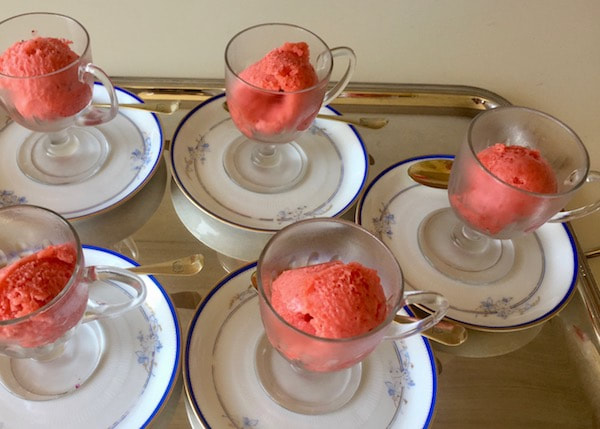










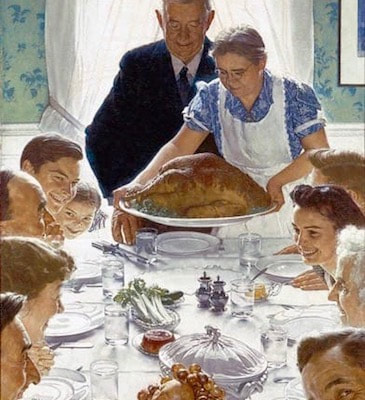



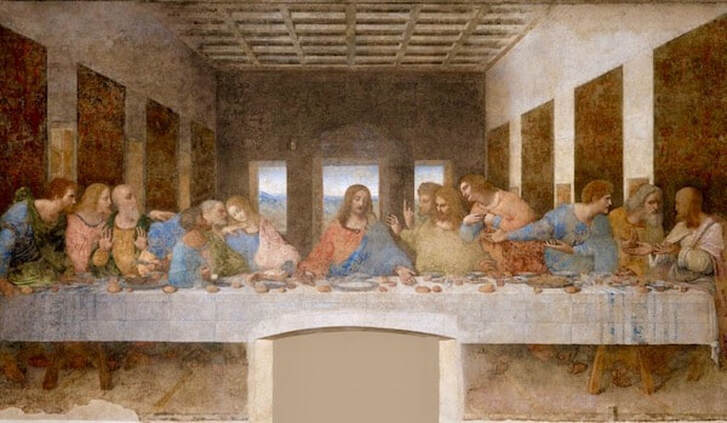
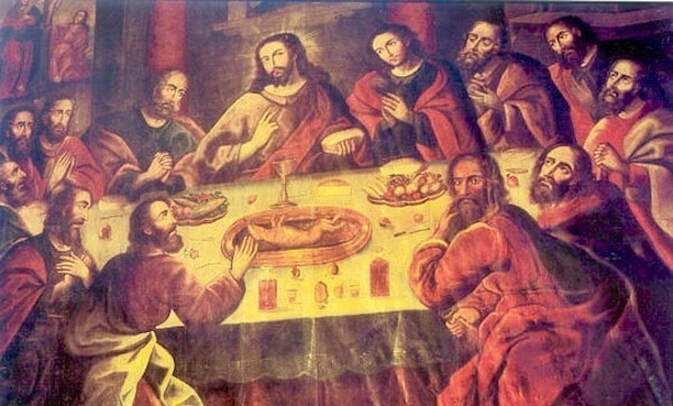




 RSS Feed
RSS Feed
